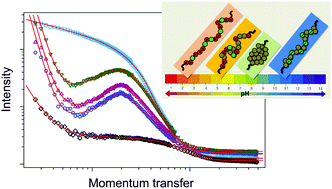pH Responsiveness of hydrogels formed by telechelic polyampholytes
Abstract
We investigate the influence of pH on the rheological and structural properties of hydrogels formed by hydrophobic association of the sticky ends of the triblock terpolymer poly(methyl methacrylate)-b-poly(2-(diethylamino)ethyl methacrylate-co-methacrylic acid)-b-poly(methyl methacrylate) (PMMA-b-P(DEA-co-MAA)-b-PMMA). The middle block is a weak polyampholyte having a pH dependent charge density and sign, which enables tuning of the rheological and structural properties by pH variation. Small-angle neutron scattering (SANS) studies of solutions in D2O at 0.05 wt% and pH 3.0 reveal clusters of interconnected spherical micelles having PMMA cores, stabilized by repulsive ionic interactions in the middle polyampholyte block. With increasing pH, the degree of ionization of the DEA units decreases, whereas the one of the MAA units increases, resulting in a complete loss of the correlation between these micelles. At a concentration of 3 wt% at low pH values, the system forms a gel with charged fuzzy spheres from PMMA interacting via a screened Coulomb potential. With increasing pH, the gel disintegrates due to the decrease in the effective charge on the micelles. At both concentrations, the hydrophobic aggregation of micelles is observed near the isoelectric point. At pH 3.0–7.4, the autocorrelation functions measured by rotational dynamic light scattering at 3 wt% exhibit a decay steeper than single exponential, which confirms that the gels are frozen, presumably due to the glassy PMMA cores and hydrophobic interpolyelectrolyte complexes. At pH 11, the diffusion of single micelles is observed in addition to the frozen dynamics.



 Please wait while we load your content...
Please wait while we load your content...